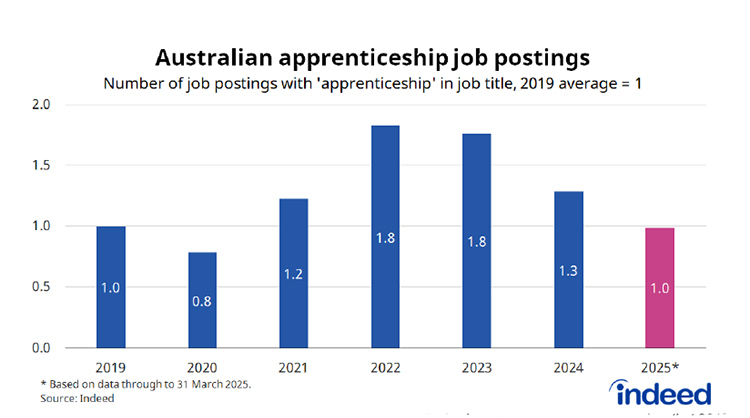Tools Down: Australia’s Apprenticeship Boom is Over

Australia’s red-hot job market for apprentices cooled considerably in 2024 and early signs suggest that trend will continue in 2025.
As recently as 2022, Australia was experiencing the second-worst labour shortages among developed countries, according to the Organisation for Economic Cooperation and Development. While those shortages have since eased, helped by strong population growth and fewer job opportunities, many skill deficits persist.
Some of the largest pain-points have been among ‘tradies,’ with apprenticeship job postings around 80% higher in 2022 and 2023 than they were in 2019. Anyone trying to build or renovate a home has run into difficulties finding electricians, plumbers and builders. These shortages have delayed infrastructure projects, threatening Australia’s ability to build essential infrastructure.
But it’s not just ‘tradies’ that are hard to find. Hair dressers are understaffed, restaurants struggle to find qualified chefs and childcare providers cannot find enough workers - all of which affect daily life.
Roughly half of occupations in the technicians & trades workers category - home to many apprenticeship-aligned roles – are in short supply, according to Jobs and Skills Australia, the highest of any occupational group.
Unfortunately, Australia’s vocational education system is also much smaller than it used to be. The number of people in training, as a share of total Australian employment, has fallen by around 47% since the 2012 financial year, while course completions have more than halved over the past decade. And in the past four years, the number of student withdrawals or cancellations exceeded completions - a previously uncommon occurrence.
Indeed data show that demand for apprenticeships and traineeships has softened recently, after spiking throughout 2022 and 2023, and is now below pre-pandemic trends nationally. Jobseeker searches for these entry-level roles have also declined, consistent with tight labour market conditions.
Demand for Apprentices Fell in 2024
As Australia emerged from the pandemic, apprentices were in high demand, with postings rising as households and businesses caught up on delayed economic activity following the 2020-21 lockdowns. At their 2022 peak, apprenticeship job postings were 82% above 2019 levels. Filling those roles was difficult, with persistent skill-shortages leaving key sectors understaffed and operating below capacity.
But after a sharp rise in 2022 and 2023, job postings mentioning apprenticeships or traineeships in their job title fell 27% in 2024 over the year. And data through the early part of 2025 suggests that apprenticeship and trainee demand has weakened further. By the end of March, apprenticeship job postings were tracking 23% below the 2024 average, and slightly below pre-pandemic levels. 
Bar graph titled “Australian apprenticeship job postings”. With a vertical axis ranging from 0 to 2, indexed so that 2019 = 1, we find that apprenticeship postings peaked in 2022 and 2023, but has since declined sharply and in 2025 so far is tracking slightly below 2019 levels.
The construction industry highlights how unusual recent years have been. The job vacancy rate peaked at 3.0% in the June quarter 2022 - more than double the 1.3% average from 2010 to 2019 - suggesting that there were around 21,000 more unfilled jobs than was typical. Even today, at 1.9%, the vacancy remains high by historical standards.
Apprentice Demand is Elevated, but Easing
In 2022, apprenticeship job postings were 169% higher in Queensland, 84% higher in South Australia and around 70% higher in the other mainland states, compared to 2019 levels.
Since then, employer demand has eased in each mainland state, albeit to varying degrees. In 2025, early signs indicate that apprenticeship postings are now below pre-pandemic levels in every mainland state except Queensland. While Queensland postings have declined 26% from their peak, they are still double their pre-pandemic baseline. That’s in stark contrast to New South Wales and Victoria, where postings have halved from their peak and are now well-below 2019 levels.
Queensland has implemented a range of jobseeker and employer-focused initiatives to bolster apprenticeship uptake, including fee-free TAFE and free apprenticeships for under 25s. And the state’s ‘Back to Work’ program offers incentive payments of up to $15,000 for employers hiring eligible unemployed jobseekers - with even higher payments for youth hires. Similar policies can be found nationwide, with both state and federal governments offering a suite of incentives to address persistent skill shortages.
Apprenticeship Opportunities are often Gender-dominated
Both men and women pursue apprenticeships and traineeships – but rarely for the same roles. Many occupations regularly hiring new apprentices are dominated by a single gender, with persistent gender stereotypes and a lack of diversity often limiting talent pipelines.
Apprenticeship postings are most common for electricians and educators, accounting for 9.1% and 6.9% of apprenticeship postings, respectively. Electricians are a male-dominated sector, with men accounting for 96% of workers.
Tradies remain overwhelmingly male. Between 97% and 98% of working plumbers (6.2% of apprenticeship postings), mechanics (4.0%) and carpenters (3.3%) are men. Education roles, by comparison, skew towards women, with 97% of early childhood teachers and 94% of childcare workers women.
Efforts to boost the number of female ‘tradies’ have gained momentum, but it could take generations to see meaningful change to the number of women working as mechanics, electricians, plumbers or carpenters. Or for that matter, men in key early education roles. Creating greater diversity by fostering more inclusive workplaces, ensuring safe working environments and overcoming corrosive gender stereotypes remains a key challenge across many of these sectors.
Overall, men accounted for three-quarters of apprentices and trainees in 2024 – the lowest share in the past decade. That figure was as high as 87% in 2020 and 84% in 2018.
Despite Incentives, Jobseeker Interest has Softened
Despite the abundance of incentives, jobseeker searches for apprenticeship and traineeship jobs have fallen since 2022. In March 2025, 1.1% of Australian jobseeker searches were for apprenticeships or traineeships, broadly consistent with average search activity in both 2023 and 2024.
However, search activity is well below levels from immediately before and during the pandemic. In 2019, around 1.7% of jobseeker searches were for apprenticeships or traineeships. That held firm throughout 2020 and 2021, before tumbling throughout 2022 when employer demand reached its peak.
At first glance, declining jobseeker activity amid elevated job creation may seem counterintuitive. But several factors are likely at play. First, less friction in the apprenticeship job market may mean apprentices are finding jobs faster, requiring fewer job searches. Second, in a tight labour market, fewer people may be pursuing entry-level roles, limiting the supply of active candidates.
Conclusion
Employer demand for apprentices and trainees declined considerably last year, and early signs point towards a similar fall in 2025. Queensland remains a standout, thanks to robust government support. But in other states, demand has slipped below pre-pandemic levels.
In recent years, the market for skilled entry-level talent greatly favoured the jobseeker. They had more choice and control over where and how they worked. But recent Indeed data suggests that dynamic has shifted, potentially giving employers the upper hand.
That said, while apprenticeship and trainee opportunities have declined, we haven’t yet seen a corresponding rebound in jobseeker activity. It suggests that these roles are still relatively easy for jobseekers to obtain - at least for now.
Methodology
An Australian apprenticeship typically involves a combination of on-the-job and structured learning. The Australian government defines an Australian apprenticeship as a combination of apprenticeships in a skilled trade, such as plumbers or electricians, as well as traineeships in non-trade occupations, such as aged care and childcare. In this blog post, we have adopted the same broad definition.
Apprenticeship or traineeship job postings are defined as those that feature phrases such as apprenticeship or traineeship in their job title. Similarly, jobseeker searches for apprenticeship or traineeship opportunities are those that use these phrases when searching for jobs on the Indeed website.
Image by Cristian Rojas